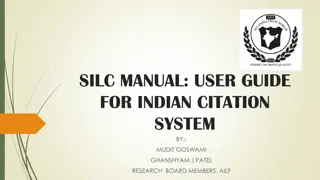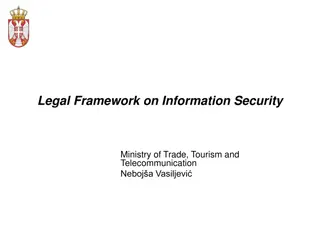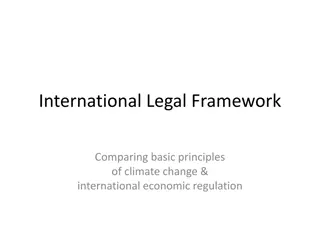Understanding International Legal Frameworks in Phytosanitary Regulations
Exploring the international legal framework surrounding phytosanitary regulations is essential for understanding obligations placed on countries to protect human, animal, and plant health. Key aspects include international treaties, soft law instruments, the WTO SPS Agreement, and the role of the World Trade Organization in trade liberalization and non-discrimination principles.
- International legal framework
- Phytosanitary regulations
- WTO SPS Agreement
- World Trade Organization
- Trade liberalization
Download Presentation

Please find below an Image/Link to download the presentation.
The content on the website is provided AS IS for your information and personal use only. It may not be sold, licensed, or shared on other websites without obtaining consent from the author. Download presentation by click this link. If you encounter any issues during the download, it is possible that the publisher has removed the file from their server.
E N D
Presentation Transcript
International Legal Framework The IPPC Secretariat With the financial support of the STDF project 401 Phytosanitary Capacity Evaluation (PCE) facilitators training
Outline 1. International Regulatory Framework 2. The SPS Agreement FAO Legal Office
International legal instruments International treaties Legally binding A source of obligations that countries must give effect to at national level. Soft law instruments Not legally binding May nonetheless have widespread acceptance and adherence Serve as valuable guidelines
International framework: the WTO SPS AGREEMENT WORLD TRADE ORGANIZATION SPS TBT AGRICULTURE OIE IPPC CODEX
World Trade Organization Established: 1st January 1995 (replacing GATT) Means to achieve objectives: 1) Trade liberalization; 2) Reduction of tariffs and other barriers to trade and elimination of discriminatory treatment in international trade relations.
Principle of non-discrimination: 1) MFN Principle 2) NT Principe Discussion: are there exceptions to the principle of non-discrimination?
World Trade Organization Sanitary Agreement (SPS Agreement) and Phytosanitary Agreement on Technical Barriers to Trade (TBT Agreement) SPS Agreement regulates: All measures to protect the lives and health of humans, animals and plants from certain specific SPS risks in the exporting country. For example: Requiring products to come from disease free-areas (FMD in South America, BSE in Canada) Demanding certification inspection procedures/standards of the Veterinary Services TBT Agreement regulates: 1.3 All products, including industrial and agricultural products, shall be subject to the provisions of this Agreement. For example: Technical regulations concerning size, shape, design, labeling, or packaging of a product. or
How do you know if a measure is SPS or TBT? Different scope: The SPS Agreement covers all measures whose purpose is to protect: human or animal health from food-borne risks; human health from animal- or plant-carried diseases; animals and plants from pests or diseases; whether or not these are technical requirements. It is the purpose of the measure that determines whether a measure is subject to the SPS Agreement. The TBT (Technical Barriers to Trade) Agreement covers all technical regulations, voluntary standards and the procedures to ensure that these are met, except when these are sanitary or phytosanitary measures as defined by the SPS Agreement. The type of measure determines whether it is covered by the TBT Agreement.
Exercise 1 In groups of two/three 1. Discuss if the following measures are SPS or TBT a) A detailed standard on the color and shape of food packages b)A detailed standard on nutritional information in labelling c) A regulation on wood boxes in international trade d)Import requirements for live animals e) A regulation on organic agriculture f) A regulation on the import of straw handicraft g) A regulation for the importation of processed cotton and fibers 2. Identify three SPS measures and three TBT measures
SPS Agreement Countries may choose their preferred level of sanitary protection but this, must be based on scientific principles and sufficient scientific evidence, must not be more stringent than necessary to achieve desired objective. 10
SPS Measures are intended to protect a Country Human Health Animal Health Plant Health from risks arising from additives, contaminants, toxins/disease causing org., plant/animal carried diseases damages caused by the entry, establishment or spread of pests additives, toxins, pests, diseases, diseases causing org. pests, diseases, diseases causing org.
Key Provisions in the SPS Agreement 1. Purpose: Maintain the sovereign right of any government to provide the level of health protection it deems appropriate, but that these rights are not misused for protectionist purposes and do not result in unnecessary barriers to international trade.
Key Provisions in the SPS Agreement 2. Technical Justification Phytosanitary measures must be applied for no other purpose than that of ensuring plant health. Members shall ensure that any sanitary or phytosanitary measure is applied only to the extent necessary to protect human, animal or plant life or health, is based on scientific principle and is not maintained without sufficient scientific evidence
Key Provisions in the SPS Agreement 3. Harmonization To harmonize sanitary and phytosanitary measures on as wide a basis as possible, Members shall base their sanitary or phytosanitary measures on international standards, guidelines or recommendations, where they exist Governments may choose not to use the international standards, but they may be asked to provide scientific justification, demonstrating that the relevant international standard would not result in the level of health protection the country considered appropriate. Sanitary or phytosanitary measures which conform to international standards, guidelines or recommendations shall be deemed to be necessary to protect human, animal or plant life or health, and presumed to be consistent
Whose International Standards? Standard-setting bodies 3 Sisters food safety FAO/WHO animal health (zoonoses) plant protection Codex = Joint FAO/WHO Codex Alimentarius Commission OIE = World Animal Health Organization IPPC = International Plant Protection Convention (FAO)
Key Provisions in the SPS Agreement 4. Types of measures Adapted to conditions: phytosanitary measures may vary, depending on the country of origin of the food, animal or plant product concerned, but this should not be used as unjustified discrimination. Alternative measures: in case of different measures technically and economically feasible and that provide the same level of protection, governments should select those which are not more trade restrictive than required to meet their health objective. if another country can show that the measures it applies provide the same level of health protection, these should be accepted as equivalent.
Key Provisions in the SPS Agreement 5. Risk Assessment Countries must establish SPS measures on the basis of an appropriate assessment of the actual risks involved, and, if requested, make known what factors they took into consideration, the assessment procedures they used and the level of risk they determined to be acceptable. In cases where relevant scientific evidence is insufficient, a Member may provisionally adopt sanitary or phytosanitary measures on the basis of available pertinent information, including that from the relevant international organizations as well as from sanitary or phytosanitary measures applied by other Members.
Key Provisions in the SPS Agreement 6. Transparency Governments are required to notify other countries of any new or changed sanitary and phytosanitary requirements which affect trade Governments assume an obligation of notification: To the WTO; To other member countries
Government Responsibility in the Implementation of the SPS Agreement Draft and implement effective legislation and other safeguards to preserve and protect the sanitary and phytosanitary status. Regulate and control domestic and foreign trade, and provide necessary support to entrepreneurs especially small scale operators. Ensure safety of imported products (plants, animals, their products, food, feed) and to take necessary regulatory and risk- avoidance measures to ensure safety standards are met. Comply with the obligations of notification.
See full size image Thank you very much Carmen Bullon - Carmen.Bullon@fao.org Lalaina Ravelomanantsoa Lalaina.Ravelomanantsoa@fao.org Legal Officers -FAO Development Law Service FAO Legal Office























